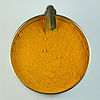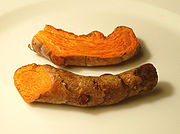Turmeric
From Wikipedia, the free encyclopedia
| Turmeric | ||||||||||
|---|---|---|---|---|---|---|---|---|---|---|
 Curcuma longa
|
||||||||||
| Scientific classification | ||||||||||
|
||||||||||
| Binomial name | ||||||||||
| Curcuma longa Linnaeus[1] |
Turmeric (Curcuma longa) is a rhizomatous herbaceous perennial plant of the ginger family, Zingiberaceae. It is native to tropical South Asia and needs temperatures between 20° C and 30° C, and a considerable amount of annual rainfall to thrive. Plants are gathered annually for their rhizomes, and re-seeded from some of those rhizomes in the following season.
The rhizomes are boiled for several hours and then dried in hot ovens, after which they are ground into a deep orange-yellow powder commonly used as a spice in curries and other South Asian and Middle Eastern cuisine, for dyeing, and to impart color to mustard condiments. Its active ingredient is curcumin and it has an earthy, bitter, peppery flavor and a mustardy smell.
In medieval Europe, turmeric became known as Indian Saffron, since it is widely used as an alternative to the far more expensive saffron spice.
Sangli, a town in the southern part of the Indian state of Maharashtra, is the largest and most important trading centre for turmeric in Asia or perhaps in the entire world.[2]
Contents |
[edit] Usage
[edit] Culinary uses
In non-South Asian recipes, turmeric is sometimes used as an agent to impart a rich, custard-like yellow color. It has found application in canned beverages, baked products, dairy products, ice cream, yogurt, yellow cakes, orange juice, biscuits, popcorn color, sweets, cake icings, cereals, sauces, gelatins, etc. It is a significant ingredient in most commercial curry powders. Turmeric is used in savory dishes, not sweet ones.
Although usually used in its dried, powdered form, Turmeric is also used fresh - much like ginger. It has numerous uses in far east recipes, such as fresh turmeric pickle (which contains large chunks of soft turmeric).
Turmeric (coded as E100 when used as a food additive) is used to protect food products from sunlight. The oleoresin is used for oil-containing products. The curcumin/polysorbate solution or curcumin powder dissolved in alcohol is used for water containing products. Over-coloring, such as in pickles, relishes and mustard, is sometimes used to compensate for fading.
In combination with annatto (E160b), turmeric has been used to color cheeses, yogurt, dry mixes, salad dressings, winter butter and margarine. Turmeric is also used to give a yellow color to some prepared mustards, canned chicken broths and other foods (often as a much cheaper replacement for saffron).
Turmeric is widely used as a spice in South Asian and Middle Eastern cooking. Momos (Nepali meat dumplings), a traditional dish in South Asia, are spiced with turmeric. In South Africa turmeric is traditionally used to give boiled white rice a golden color.
[edit] Medicinal uses
In Ayurvedic practices, turmeric is thought to have many medicinal properties and many in South Asia (particularly India) use it as a readily available antiseptic for cuts, burns and bruises. Practitioners of Ayurvedic medicine say it has fluoride which is thought to be essential for teeth. It is also used as an antibacterial agent.
It is taken in some Asian countries as a dietary supplement, which allegedly helps with stomach problems and other ailments. It is popular as a tea in Okinawa, Japan. Pakistanis also use it as an anti-inflammatory agent, and remedy for gastrointestinal discomfort associated with irritable bowel syndrome, and other digestive disorders. In Afghanistan and North West Pakistan, turmeric is applied to a piece of burnt cloth, and placed over a wound to cleanse and stimulate recovery. Indians, in addition to its Ayurvedic properties, use turmeric in a wide variety of skin creams that are also exported to neighboring countries. It is currently being investigated for possible benefits in Alzheimer's disease, cancer and liver disorders.
It is only in recent years that Western scientists have increasingly recognised the medicinal properties of turmeric. In the latter half of the 20th century, curcumin was identified as responsible for most of the biological effects of turmeric. According to a 2005 article in the Wall Street Journal, research activity into curcumin is exploding. In that year supplement sales increased 35% from 2004, and the U.S. National Institutes of Health had four clinical trials underway to study curcumin treatment for pancreatic cancer, multiple myeloma, Alzheimer's, and colorectal cancer. Of great interest in the field of Neuroscience is the fact that one of its major functional chemical components enhance the production of BDNF (Brain Derived Neurotrophic Factor). Other BDNF enchancing factors include Glutamate, Exercise, Caloric Restriction, Intellectual Stimulation, and brain injury (as a compensatory mechanism).
[edit] Cosmetics
| This section requires expansion. |
Turmeric is currently used in the formulation of some sunscreens. Turmeric paste is used by some Indian women to keep them free of superfluous hair. Turmeric paste is applied to bride and groom before marriage in some places of India, Bangladesh, and Pakistan, where it is believed turmeric gives glow to skin and keeps some harmful bacteria away from the body.
The government of Thailand is funding a project to extract and isolate tetrahydrocurcuminoids (THC) from turmeric. THCs (not to be confused with tetrahydrocannabinol, which is also known as THC) are colorless compounds that might have antioxidant and skin-lightening properties and might be used to treat skin inflammations, making these compounds useful in cosmetics formulations.
[edit] Dye
Turmeric makes a poor fabric dye as it is not very lightfast (the degree to which a dye resists fading due to light exposure). However, turmeric is commonly used in Indian clothing, such as saris.
[edit] Gardening
Turmeric can also be used to deter ants. The exact reasons why turmeric repels ants is unknown, but anecdotal evidence suggests it works.[citation needed]
[edit] Ceremonial uses
Turmeric is also used in various rituals, such as the turmeric ceremony or gaye holud, part of the Bengali wedding.It is widely used in all parts of India during wedding ceremony particularly, North India and Deccan Plateau.
Also, it is used in Pujas as a form of the elephant God Ganesha. It is made by mixing turmeric with water and forming it into a cone like shape.
[edit] Automotive uses
Turmeric is one of the main ingredients in leading radiator stop-leak sealant mixtures.
[edit] Chemistry
Turmeric contains up to 5% essential oils and up to 3% curcumin, a polyphenol. It is the active substance of turmeric and it is also known as C.I. 75300, or Natural Yellow 3. The systematic chemical name is (1E,6E)-1,7-bis(4-hydroxy-3-methoxyphenyl)-1,6-heptadiene-3,5-dione.
It can exist at least in two tautomeric forms, keto and enol. The keto form is preferred in solid phase and the enol form in solution.
[edit] References
- ^ "Curcuma longa information from NPGS/GRIN". www.ars-grin.gov. http://www.ars-grin.gov/cgi-bin/npgs/html/taxon.pl?12676. Retrieved on 2008-03-04.
- ^ SANGLI...The Turmeric City of India n home of brights
[edit] External links
- Turmeric benefits, health uses, and side effects
- Turmeric, from the U.S. National Institutes of Health
- Turmeric List of Chemicals (Dr. Duke's)
- Plant Cultures: review of botany, history and uses
|
|||||||||||







